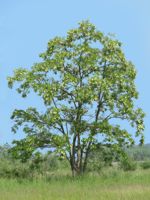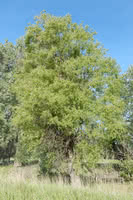Mon-Fri 9am - 5pm Mountain time
Black Locust vs Peachleaf Willow
Robinia pseudoacacia
Salix amygdaloides
NOT AVAILABLE THIS SEASON - MIGHT RETURN
Black Locust is an attractive tree. Its distinctive leaves are made of about a dozen bright green leaflets. It also notable for its fragrant white flowers, which smell of citrus.
Black Locust can grow in many situations, but prefers dry areas with lots of sun. It is robust and is an excellent choice for establishing shade in dry, open areas.
Important note: Much of the Black Locust is toxic to humans and livestock, including seeds, bark, and leaves.
The Peachleaf Willow is often a multi-stemmed willow that generally grows into a tall shrub. This versatile and useful small tree is often seen in riparian zones and erosion control projects. Wildlife rely on the twigs, foliage and bark for food.
A widely distributed willow species, it's long pointed leaves are dark green on top and pale green underneath. The Peachleaf Willow is the tallest of the native prairie willows reaching 40ft in height.

